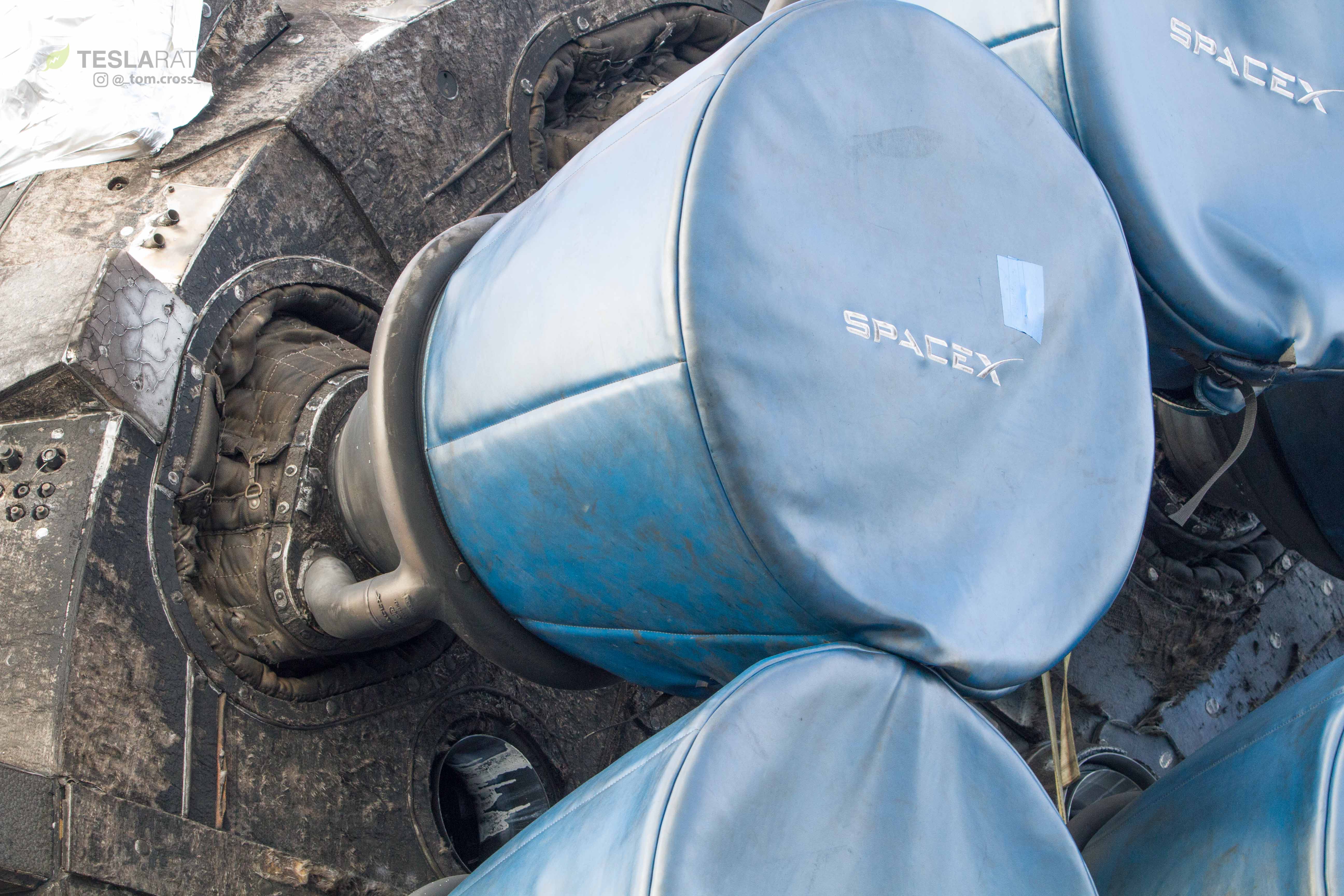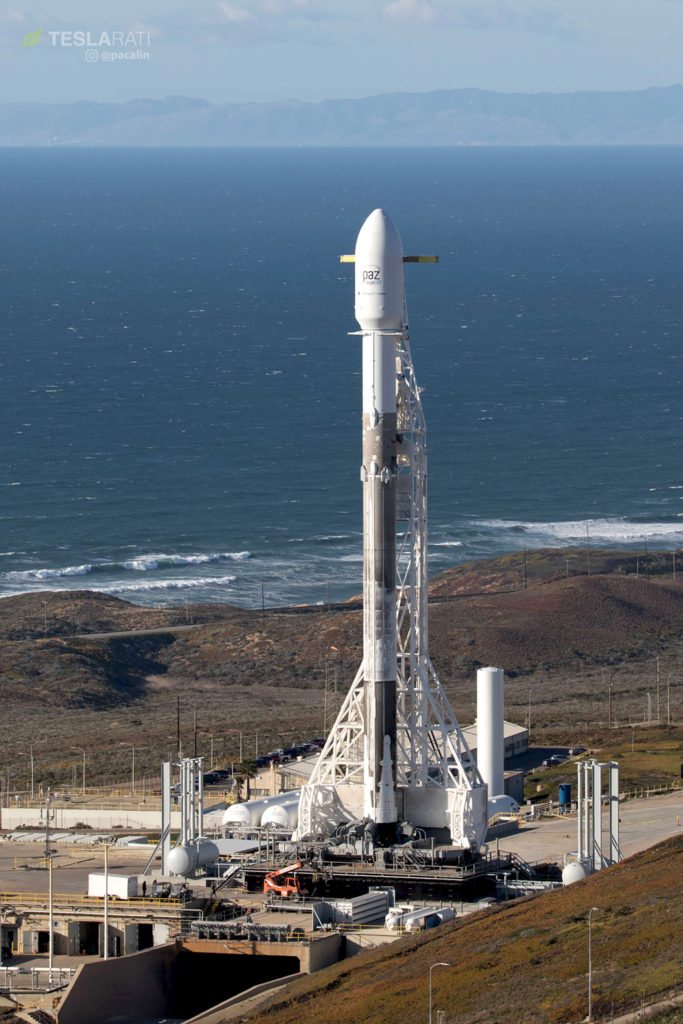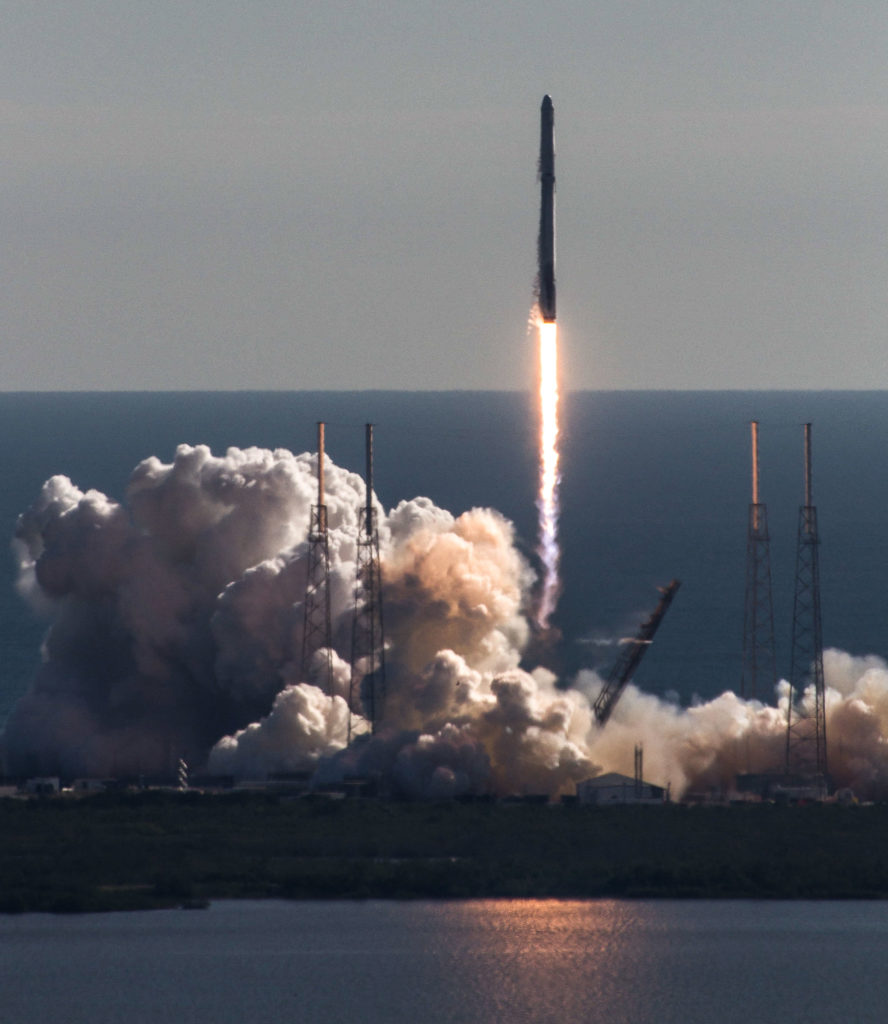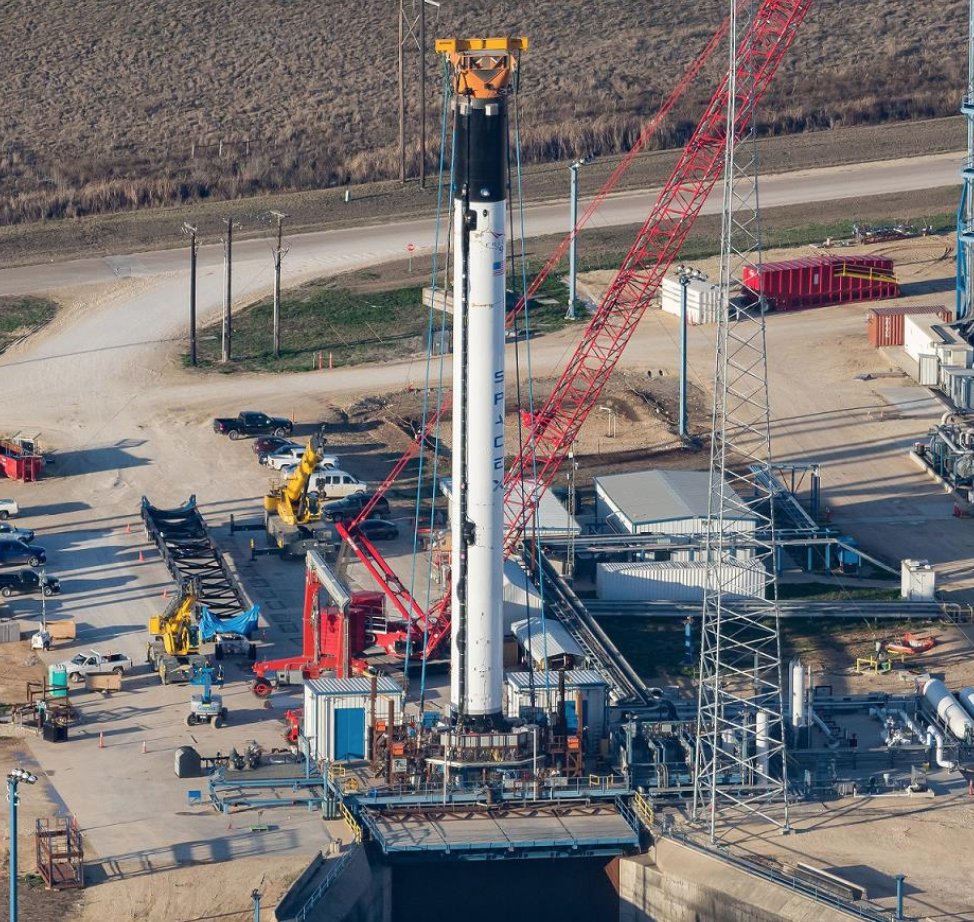

News
SpaceX aims for 3 rocket launches in a single week, 6 launches in 1 month
Tailing an intense February that saw SpaceX successfully complete inaugural launches of both Falcon Heavy and two Starlink prototype satellites, the next three weeks of March are likely to be relatively quiet. However, by all appearances, SpaceX is preparing for a frenetic end-of-month that could include three Falcon 9 launches from three separate SpaceX launch pads, all in a single week, and as many as six launches total between March 29 and April 30.
If successful, this series of missions would smash all of SpaceX’s past launch cadence records – six launches in little more than a single month, two reused flights in four days, three launches in one week, and two East coast launches in three days, not to mention the debut of Falcon 9 Block 5. To put this level of activity in perspective, SpaceX could complete the equivalent of four months or 33% of all of their 2017 launches in a single month. SpaceX’s aggressive goal of 30 launches in 2018 still means that the company could complete a full 1/5th of their scheduled manifest in less than five weeks, a cadence that – if maintained for a full year – would equate to 60-70 launches in 12 months.

50 launches of Falcon 9 in seven and a half years. Graphic produced by Reddit user ethan829. (Reddit /u/ethan829)
Three launches, three pads, seven days
Beginning on March 29, SpaceX’s next series of launches will kick off with the flight-proven Iridium-5 mission tasked with placing 10 Iridium NEXT communications satellites into LEO from Vandenberg Air Force Base. Three days later (April 2), a flight-proven Cargo Dragon and Falcon 9 booster are scheduled to lift off from LC-40 on the East coast, likely followed by the first stage’s second landing at LZ-1. Finally, SpaceX will return Pad 39A to its first single-stick Falcon 9 launches since February’s inaugural Falcon Heavy flight with Bangabandhu-1, the Bangladesh government’s first-ever geostationary satellite. Bangabandhu-1 will also mark the inaugural launch of SpaceX’ potentially game-changing Falcon 9 upgrade, and that invaluable pathfinder booster will almost certainly find its way to a soft landing aboard the Atlantic drone ship Of Course I Still Love You (OCISLY).
Following those three launches and around ten days of quiet, SpaceX will launch NASA’s TESS, a scientific probe tasked with searching for planets beyond our solar system, from Florida’s LC-40, April 16. After another ten-day “break,” the company will jump back to the West coast to place another five Iridium NEXT satellites (and two NASA science payloads) into orbit on April 28. On April 30, just two days later, SES-12 is scheduled for an East coast launch to geostationary transfer orbit aboard a reused Falcon 9.
- SpaceX intends to launch three Falcon 9s from all three of its pads in just seven days. Pictured here their VAFB pad in California. (Pauline Acalin)
- A reused Falcon 9 clears the lightning towers of Florida’s Launch Complex-40 (LC-40). (Tom Cross)
- Falcon Heavy explodes off of Pad 39A in a spectacle of fire, Roadster in tow. (Tom Cross)
A new era of rapid reusability rears its head
Put simply, this is an extreme pace for orbital launches, and would be an absolutely staggering achievement for SpaceX even if Hispasat’s week-long delay extends that month-long period to six or so weeks for a half-dozen launches. While almost certainly a coincidence, this rapid succession of launches happens to coincide with the inaugural April 5th launch of SpaceX’s next-generation Falcon 9, an upgrade meant to enable cheap and rapid reuse of the rocket’s first stage. With Block 5, it is entirely conceivable that a Falcon 9 booster could land at LZ-1, be transported back to the launch pad after a brief once-over, and conduct another launch in a matter of days, at a meaningful cost of little more than the second stage and payload fairing (for the time being, at least). Of course, those minimal costs will at first help SpaceX recoup its considerable investments in reusability, but they can be expected to trickle down to the customer within a year or two (~30-60 launches) of Block 5’s introduction.
- SpaceX Block 5 Falcon9 at McGregor, Texas [Credit: Chris G – NSF via Twitter, Reprinted with permission from NASASpaceflight.com]
- A matte-silver Block 5 Merlin 1D rocket engine seen preparing to leave SpaceX’s Hawthorne factory for testing in Texas. (SpaceX)
Ultimately, Falcon 9 Block 5 will give SpaceX an unprecedented amount of capital flexibility. Once the upgrade has phased out older Falcons, the company will have a huge amount of freedom to constantly strike a balance between competitive pricing and profit margins. In other words, no launch provider on Earth will be able to lowball SpaceX on cost without SpaceX’s conscious acquiescence, and every single recoverable launch of a Block 5 will equate to profit margins previously inconceivable for the company. However, rather than lining the pockets of military-industrial complex profiteers, those profits will help SpaceX both pay off R&D debts and intensively invest in more thrilling hardware developments, including Crew Dragon, Starlink, Raptor, BFR/BFS, and beyond. SpaceX does not intend to become rich and lazy in their success — they mean to develop technology that will provide affordable internet on a global scale, return humanity to the moon, and one day establish a permanent and self-sustaining city on Mars.
Follow us for live updates, behind-the-scenes sneak peeks, and a sea of beautiful photos from both our East and West coast photographers.
Teslarati – Instagram – Twitter
Tom Cross – Twitter
Pauline Acalin – Twitter
Eric Ralph – Twitter
Elon Musk
Tesla Supercharger Diner food menu gets a sneak peek as construction closes out
What are you ordering at the Tesla Diner?

The Tesla Supercharger Diner in Los Angeles is nearing completion as construction appears to be winding down significantly. However, the more minor details, such as what the company will serve at its 50s-style diner for food, are starting to be revealed.
Tesla’s Supercharger Diner is set to open soon, seven years after CEO Elon Musk first drafted the idea in a post on X in 2018. Musk has largely come through on most of what he envisioned for the project: the diner, the massive movie screens, and the intended vibe are all present, thanks to the aerial and ground footage shared on social media.
We already know the Diner will be open 24/7, based on decals placed on the front door of the restaurant that were shared earlier this week. We assume that Tesla Optimus will come into play for these long and uninterrupted hours.
The Tesla Diner is basically finished—here’s what it looks like
As far as the food, Tesla does have an email also printed on the front door of the Diner, but we did not receive any response back (yet) about what cuisine it will be offering. We figured it would be nothing fancy and it would be typical diner staples: burgers, fries, wings, milkshakes, etc.
According to pictures taken by @Tesla_lighting_, which were shared by Not a Tesla App, the food will be just that: quick and affordable meals that diners do well. It’s nothing crazy, just typical staples you’d find at any diner, just with a Tesla twist:
Tesla Diner food:
• Burgers
• Fries
• Chicken Wings
• Hot Dogs
• Hand-spun milkshakes
• And more https://t.co/kzFf20YZQq pic.twitter.com/aRv02TzouY— Sawyer Merritt (@SawyerMerritt) July 17, 2025
As the food menu is finalized, we will be sure to share any details Tesla provides, including a full list of what will be served and its prices.
Additionally, the entire property appears to be nearing its final construction stages, and it seems it may even be nearing completion. The movie screens are already up and showing videos of things like SpaceX launches.
There are many cars already using the Superchargers at the restaurant, and employees inside the facility look to be putting the finishing touches on the interior.
🚨 Boots on the ground at the Tesla Diner:
— TESLARATI (@Teslarati) July 17, 2025
It’s almost reminiscent of a Tesla version of a Buc-ee’s, a southern staple convenience store that offers much more than a traditional gas station. Of course, Tesla’s version is futuristic and more catered to the company’s image, but the idea is the same.
It’s a one-stop shop for anything you’d need to recharge as a Tesla owner. Los Angeles building permits have not yet revealed the date for the restaurant’s initial operation, but Tesla may have its eye on a target date that will likely be announced during next week’s Earnings Call.
News
Tesla’s longer Model Y did not scale back requests for this vehicle type from fans
Tesla fans are happy with the new Model Y, but they’re still vocal about the need for something else.

Tesla launched a slightly longer version of the Model Y all-electric crossover in China, and with it being extremely likely that the vehicle will make its way to other markets, including the United States, fans are still looking for something more.
The new Model Y L in China boasts a slightly larger wheelbase than its original version, giving slightly more interior room with a sixth seat, thanks to a third row.
Tesla exec hints at useful and potentially killer Model Y L feature
Tesla has said throughout the past year that it would focus on developing its affordable, compact models, which were set to begin production in the first half of the year. The company has not indicated whether it met that timeline or not, but many are hoping to see unveilings of those designs potentially during the Q3 earnings call.
However, the modifications to the Model Y, which have not yet been officially announced for any markets outside of China, still don’t seem to be what owners and fans are looking forward to. Instead, they are hoping for something larger.
A few months ago, I reported on the overall consensus within the Tesla community that the company needs a full-size SUV, minivan, or even a cargo van that would be ideal for camping or business use.
Tesla is missing one type of vehicle in its lineup and fans want it fast
That mentality still seems very present amongst fans and owners, who state that a full-size SUV with enough seating for a larger family, more capability in terms of cargo space for camping or business operation, and something to compete with gas cars like the Chevrolet Tahoe, Ford Expedition, or electric ones like the Volkswagen ID.BUZZ.
We asked the question on X, and Tesla fans were nearly unanimously in support of a larger SUV or minivan-type vehicle for the company’s lineup:
🚨 More and more people are *still* saying that, despite this new, longer Model Y, Tesla still needs a true three-row SUV
Do you agree? https://t.co/QmbRDcCE08 pic.twitter.com/p6m5zB4sDZ
— TESLARATI (@Teslarati) July 16, 2025
Here’s what some of the respondents said:
100% agree, we need a larger vehicle.
Our model Y is quickly getting too small for our family of 5 as the kids grow. A slightly longer Y with an extra seat is nice but it’s not enough if you’re looking to take it on road trips/vacations/ kids sports gear etc.
Unfortunately we…
— Anthony Hunter (@_LiarsDice_) July 17, 2025
Had to buy a Kia Carnival Hybrid because Tesla doesn’t have a true 3 row vehicle with proper space and respectable range. pic.twitter.com/pzwFyHU8Gi
— Neil, like the astronaut (@Neileeyo) July 17, 2025
Agreed! I’m not sure who created this but I liked it enough to save it. pic.twitter.com/Sof5nMehjS
— 🦉Wise Words of Wisdom – Inspirational Quotes (IQ) (@WiseWordsIQ) July 16, 2025
Tesla is certainly aware that many of its owners would like the company to develop something larger that competes with the large SUVs on the market.
However, it has not stated that anything like that is in the current plans for future vehicles, as it has made a concerted effort to develop Robotaxi alongside the affordable, compact models that it claims are in development.
It has already unveiled the Robovan, a people-mover that can seat up to 20 passengers in a lounge-like interior.
The Robovan will be completely driverless, so it’s unlikely we will see it before the release of a fully autonomous Full Self-Driving suite from Tesla.
Energy
Tesla launches first Virtual Power Plant in UK – get paid to use solar
Tesla has launched its first-ever Virtual Power Plant program in the United Kingdom.

Tesla has launched its first-ever Virtual Power Plant program in the United Kingdom. This feature enables users of solar panels and energy storage systems to sell their excess energy back to the grid.
Tesla is utilizing Octopus Energy, a British renewable energy company that operates in multiple markets, including the UK, France, Germany, Italy, Spain, Australia, Japan, New Zealand, and the United States, as the provider for the VPP launch in the region.
The company states that those who enroll in the program can earn up to £300 per month.
Tesla has operated several VPP programs worldwide, most notably in California, Texas, Connecticut, and the U.S. territory of Puerto Rico. This is not the first time Tesla has operated a VPP outside the United States, as there are programs in Australia, Japan, and New Zealand.
This is its first in the UK:
Our first VPP in the UK
You can get paid to share your energy – store excess energy in your Powerwall & sell it back to the grid
You’re making £££ and the community is powered by clean energy
Win-win pic.twitter.com/evhMtJpgy1
— Tesla UK (@tesla_uk) July 17, 2025
Tesla is not the only company that is working with Octopus Energy in the UK for the VPP, as it joins SolarEdge, GivEnergy, and Enphase as other companies that utilize the Octopus platform for their project operations.
It has been six years since Tesla launched its first VPP, as it started its first in Australia back in 2019. In 2024, Tesla paid out over $10 million to those participating in the program.
Participating in the VPP program that Tesla offers not only provides enrolled individuals with the opportunity to earn money, but it also contributes to grid stabilization by supporting local energy grids.
-

 Elon Musk1 day ago
Elon Musk1 day agoWaymo responds to Tesla’s Robotaxi expansion in Austin with bold statement
-

 News1 day ago
News1 day agoTesla exec hints at useful and potentially killer Model Y L feature
-

 Elon Musk2 days ago
Elon Musk2 days agoElon Musk reveals SpaceX’s target for Starship’s 10th launch
-

 Elon Musk3 days ago
Elon Musk3 days agoTesla ups Robotaxi fare price to another comical figure with service area expansion
-

 News1 day ago
News1 day agoTesla’s longer Model Y did not scale back requests for this vehicle type from fans
-

 News1 day ago
News1 day ago“Worthy of respect:” Six-seat Model Y L acknowledged by Tesla China’s biggest rivals
-

 News2 days ago
News2 days agoFirst glimpse of Tesla Model Y with six seats and extended wheelbase
-

 Elon Musk2 days ago
Elon Musk2 days agoElon Musk confirms Tesla is already rolling out a new feature for in-car Grok





















